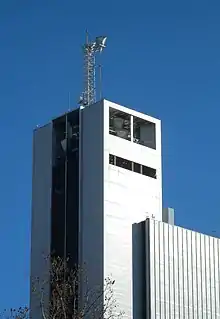空间分集
空间分集(英語:)也叫天线分集(英語:),是一种在发射端或(和)接收端安装多根不同位置的天线的分集技术。若这些天线的距离足够大,则电磁波受到衰落的影响就相互独立[1]。

在一個陽光明媚的傍晚,從第 10 大道 811 號的第 11 大道向東北方向看,原來的 Hogg 天線和後來的天線安裝得更高,用於威徹斯特/康涅狄格鏈路上的天線分集抗衰減。
一个详细的空间分集的分集改善系数计算公式[2][3][4]:
其中 为站距(km), 为无分集时衰落深度(dB), 为工作频率(GHz),, 和 为两个空间分集天线的增益(dB), 为衰落因子, 为分集接收天线间的垂直距离(m)。
参考文献
- 庞宝茂, 肖刚, 杜思深等.现代移动通信[M]. 北京: 清华大学出版社, 2004: 69.
- 姚冬苹, 黄 清, 赵红礼. 数字微波通信[M]. 北京: 清华大学出版社, 2004: 129.
- Basile L. Agba, Robert Morin, Germain Bergeron. Comparison of Microwave Links Prediction Methods: Barnett-Vigants vs. ITU Models (页面存档备份,存于)[C]. PIERS Proceedings. Xi'an, China, 2010: 788-792.
- Harry R. Anderson. Fixed Broadband Wireless System Design[M]. John Wiley and Sons, 2003: 373.
This article is issued from Wikipedia. The text is licensed under Creative Commons - Attribution - Sharealike. Additional terms may apply for the media files.